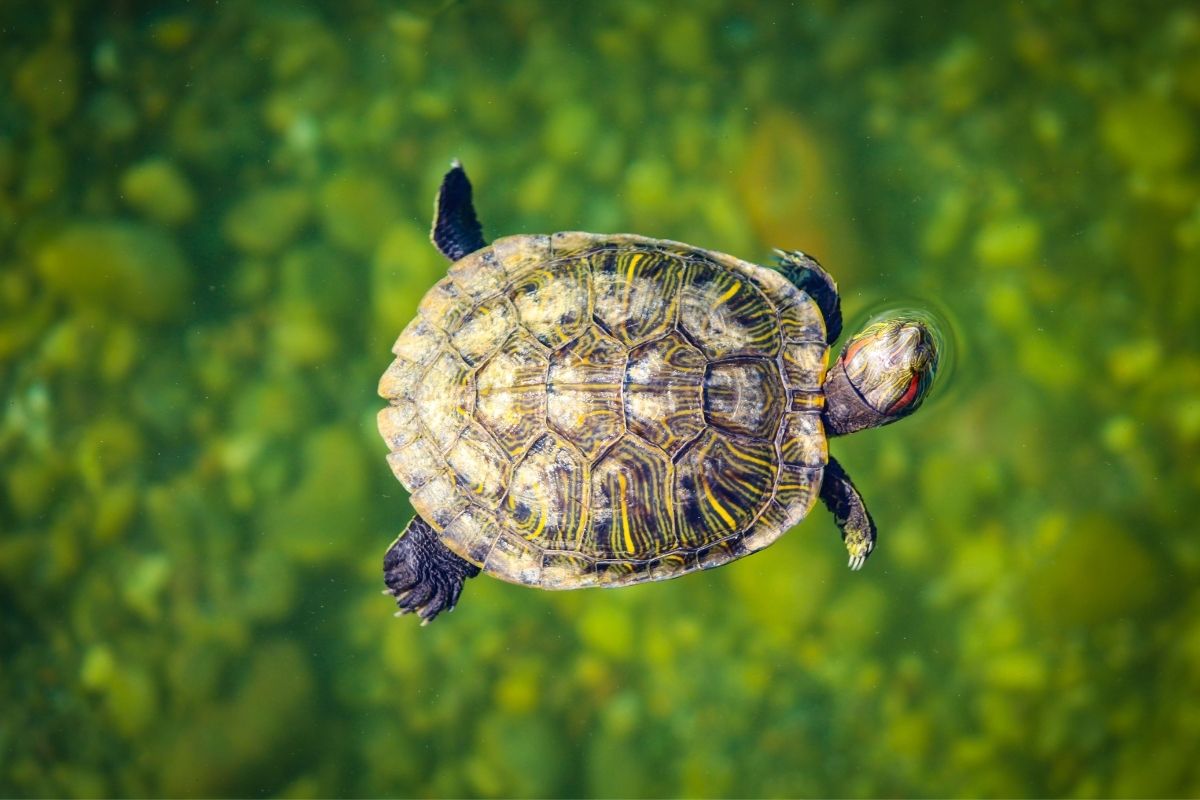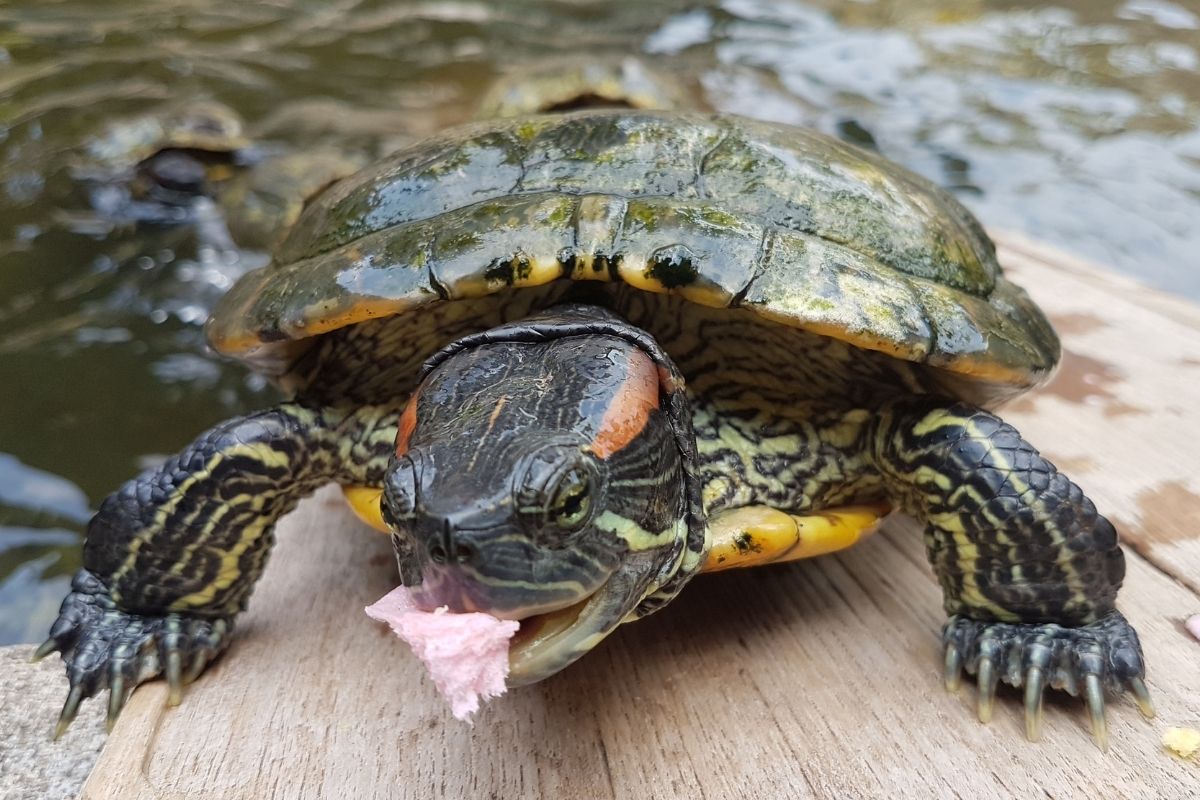Turtles are reptiles that can live both in water and on land. They spend much of their time hiding under thick vegetation, and rocks as well as inside their thick shells!
For this reason, a healthy and strong shell is absolutely essential for all types of turtles.

If you’re currently noticing that your turtle’s shell has begun to become quite soft, then it is more than likely that your turtle is suffering from a calcium deficiency.
Without healthy levels of calcium, a turtle’s shell will typically start to become soft and weak, although a variety of other infections can also be to blame.
In this article, we are going to be taking a closer look at some of the different reasons that might be causing your turtle’s shell to become soft and weak.
Along the way, we will also be providing you with some guidance on what you can do to help re-strengthen it.
Read on!
What Is The Shell Of A Turtle Made Up Of?
Before we get any further, you might be interested to learn a little more about what the shell of a turtle is actually made up of – this will help you to better understand why it might be becoming weak.
Essentially, the shell of a turtle is made out of calcium carbonate. It is hard enough to withstand the pressure from the surrounding environment but it also has some special properties that make it so flexible and strong.
The outer layer of the shell is called the carapace. This is the hardest part of the shell and is covered with small bumps called osteons. These tiny bones provide strength to the shell while also allowing it to bend easily.
The next layer is the plastron which is the bottom half of the shell. This is where most of the ribs are located. The ribs run along the length of the shell and they hold the shell together by connecting each section.
Finally, there is the upper portion of the shell which is known as the operculum.
What Causes A Soft Shell In Turtles?

There are many different factors that could be responsible for why your turtle’s shell has started to become so soft. Some of these include:
Low Calcium Levels
Calcium is a very important mineral for any animal, including turtles. It helps to build bones, teeth, muscles, and even blood vessels.
If your turtle doesn’t have enough calcium in its diet, then it won’t be able to properly maintain its tough shell, and this will, in turn, cause your turtle’s shell to start to become weak, brittle, and soft.
The best way to make sure that your turtle is getting enough calcium is to feed them food that is high in it.
Poor Diet
This ties in closely to the point above. The next thing to consider is whether, or not, your turtle is getting enough calcium in its diet. The most common sources of calcium in a turtle’s diet are insects and worms.
However, if your turtle isn’t eating enough of them, then you may need to supplement its food with calcium supplements. Providing your turtle with a balanced, healthy diet will also ensure that your turtle is optimally healthy, too.
Stress & Illness
It is also worth noting that stress and illness can cause a turtle’s shell to become very thin and weak.
If your turtle is experiencing any kind of physical or emotional trauma, then it will often try to hide away in order to avoid being hurt again.
As a result, it may stop eating and drinking, which will lead to dehydration, hunger, and potential mineral deficiencies that could cause a weakened shell.
Harsh Water Conditions
Another factor that can affect a turtle’s shell is water conditions. If there is too much chlorine in the water, then it can actually damage the shell over time. This is because chlorine tends to dissolve calcium out of the shell.
Too Much Sunlight
As with chlorine, sunlight can also damage a turtle’s shell.
When exposed to direct sunlight, the shell begins to dry out and crack. This can happen when a turtle is basking in the sun during the day, or when it is spending long periods of time outside without sheltering.
Bacterial Infections
Finally, a variety of different bacterial infections can cause your turtle’s shell to become weakened.
In particular, a parasite infection can cause a turtle’s shell to get softer. These parasites can enter the body through the mouth, eyes, or skin.
It’s vital to seek veterinary assistance if your turtle is suffering from a bacterial infection.
How Can I Help To Re-Strengthen My Turtle’s Shell?

If you think that your turtle’s shell is starting to show signs of weakness, then you should start looking into ways that you can help to strengthen it.
There are three main things that you can do:
Make Sure That Your Turtle Has Enough Calcium
If you notice that your turtle is losing weight, then this might mean that it is lacking calcium in its diet.
You should therefore make sure that it is receiving an adequate amount of calcium by feeding it some calcium-rich foods like crickets or mealworms.
Seek Veterinary Assistance
If your turtle has been diagnosed with a parasite infection, then you should seek veterinary care immediately.
A vet will be able to treat your turtle and remove the parasite from its system. Once the parasite has been removed, then it will no longer be able to harm your turtle.
Ensure A Safe Living Environment
Last but not least, you should also make sure that your turtle has a safe living environment that includes plenty of shady spaces that your turtle can retreat to out of the sunlight, as well as ensure that your turtle is exposed to water that does not contain large amounts of chlorine or other chemicals.
This water conditioner is a great product to use as it kills chemicals and contains electrolytes that will actually help to strengthen your turtle’s shell from infections.
Final Thoughts
In conclusion, turtles have shells that protect their bodies from predators and other dangers.
However, these shells can become damaged for a variety of different reasons. It is important that you look after your turtle so that it doesn’t suffer any ill effects as a result of its shell becoming weaker.
By following the tips above, you can ensure that your turtle’s shell stays strong and healthy.
Thank you for reading!
